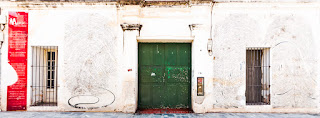Is the second largest
city in Argentina founded in 1573 and named after Cordoba in Spain. Above is
the monument of San Martin, Argentina’s liberator from the Spanish Empire. It
is home to the sixth oldest university in the New World founded by the Jesuit
Order in 1613 who ran it until 1767 when it was kicked out of Spain and Portugal
and its colonies. At that time, it was
taken over by the Franciscans; the same happened in the California missions.
Below is the façade of the University’s original building and next is the
statue of the founder of the University and next a door with the logo of the
Jesuit Order over it.
There is Natural History Museum since the Sciences
Department is located here. And yes, there is a dinosaur; Argentina is rich in
this extinct fauna. There is also a giant spider alleged the biggest so far
discovered, with a legspan estimated 20 inches; I highlighted the body of the spider. The faculty has a sense of humor; one wall
has a mosaic of Mendeleev and his Table of the Elements, as well as one of
Einstein. But they could not leave out Darwin; during his voyage of the Beagle
he spent considerable time exploring Patagonia.






The Jesuit Bloc is the center of the original colonial city
built by the Jesuits and is where the
University is located as well as the other religious institutions. Below is the
Basilica de Santo Domingo, the main Jesuit Church. At the end of the stairs is an offertory
where those that received miracles would post notices of their cures or
favors. This is common in Catholic
churches particularly in Spain and throughout Latin America. The silver and gold
Reliquary is usually located in the main altar; this was placed in a secure
place so it may have a great value.
The priest in the poster is Jose Gabriel Brochero
(1849-1914), also known as the “Gaucho Priest.”
While I was there in September it was expected that he would be
recognized as a saint; it happened the next month when the current Argentine
Pope Francis canonized him.
In the Convent of San Jose de Carmelitas Descalzas founded
in 1628 the locutorio (below) is a room where the nuns were visited by their
families who occupied the section where the chairs are. In the interior room seen across the double
grilled window, the nun accompanied by a chaperone communicated with the
family. The grilled window represents
the separation between the world and the life dedicated to prayer and strict
discipline. When the Carmelite nuns attended mass in the church, there was a
similar arrangement to keep them separate from the lay world. The painting
below is that of the founder of the order, Saint Teresa de Jesus. It represents
a story of her childhood when with her brother, she escaped from her home to
fight the Moors in Spain in search of martyrdom. But they were discovered by an uncle who
returned them to their home.


The Cathedral Nuestra Señora de la Asunción is the oldest
church in continuous use in Argentina. Entering it to the right is the tomb of
General Jose Maria Paz with a long military history starting during the war of
Independence with Spain where he fought with San Martin in Peru, then
participated in wars against Brazil, the Argentine Civil War where he attained
several victories, and others. He was imprisoned, exiled and eventually
restored during his life and died in Buenos Aires. The statue in front of his Sarcophagus is
that of his wife, Margarita Weild, who is buried there too. The chess players are in a park behind the
cathedral.
The Jesuit Bloc is a busy place with lots of restaurants and
shopping areas. As in other Argentine cities, it appears that there was an era
between the end of the XIX
th and beginning of the XX
th
Centuries from the architectural styles as seen in the image below. The
building with the columns used to be a bank and now is an art center.
And there are lots of people making a living acting as
clowns and playing music and a multitude of peddlers selling whatever is
imaginable. And as always, citizens warning me to be careful with my cameras and wallets.
The building with the green door and giant fingerprints is a
memorial to the victims of the military dictatorship during 1976-1983. The
lines in the fingerprints are formed with the names of those who disappeared
during that period. And finally, the
largest mural I have seen in my travels; it is a façade facing a parking lot
depicting the history of the countryside in Argentina. The bird to the left is that of a South
American Cardinal and to the right is the giant mud nest of a hornero
(ovenbird). The first panoramic image was taken with an iPhone since the 12 mm
lens I had was not wide enough to capture the whole mural. The other images are to give more details and idea of big of
the mural is.
Cardinal Ovenbird nest
Ovenbird nest


































2 comments:
A 2mm spider is enough to scare most people let alone 20 inches. LOL!!
This is a beautiful historical post Jose with fantastic pictures as always. Thank you for sharing.
Todavía no puedo creer que estuviste en Córdoba y nosotros no estábamos, que mala suerte, cuanto nos hubiera gustado verte después de tanto tiempo!!!!. Excelente tu reseña histórica de la ciudad y las fotos divinas como siempre, un abrazo enorme Marlis
Post a Comment